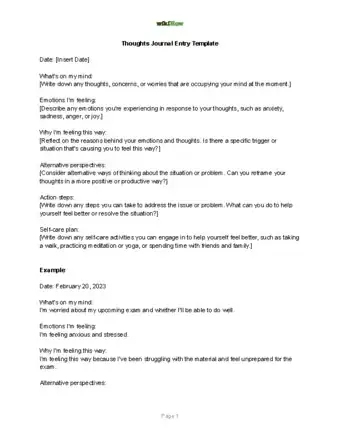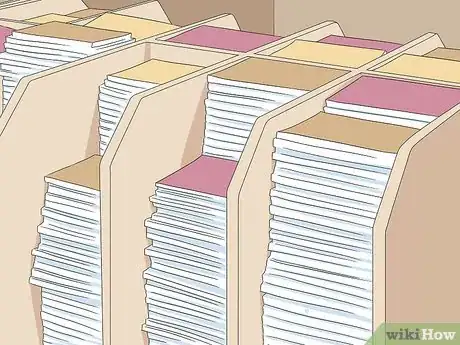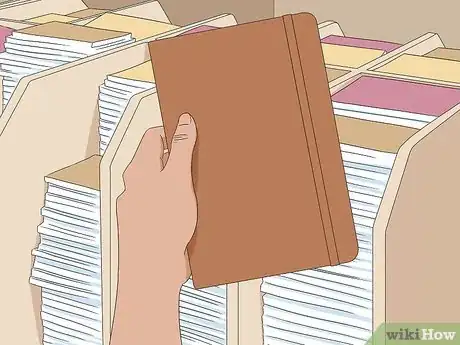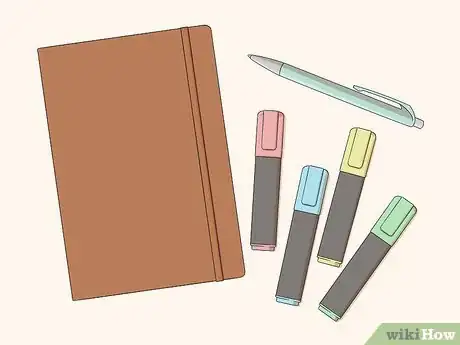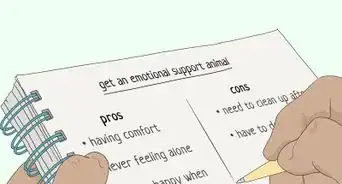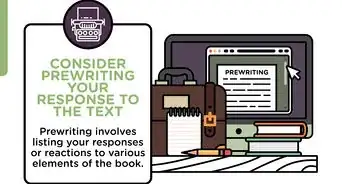This article was co-authored by Sandra Possing. Sandra Possing is a life coach, speaker, and entrepreneur based in the San Francisco Bay Area. Sandra specializes in one-on-one coaching with a focus on mindset and leadership transformation. Sandra received her coaching training from The Coaches Training Institute and has seven years of life coaching experience. She holds a BA in Anthropology from the University of California, Los Angeles.
wikiHow marks an article as reader-approved once it receives enough positive feedback. In this case, 89% of readers who voted found the article helpful, earning it our reader-approved status.
This article has been viewed 39,317 times.
Everyone needs a constructive way to process their emotions every now and then. Writing about your thoughts is a good way to both let go of your emotions, and to reflect on how you are feeling at certain times, from feeling depressed to feeling euphoric. Thought journals really help you by opening up the emotions, exploring them more closely and identifying the triggers so that you can learn to better manage your feelings. Here are a few tips and pointers that will help you write a journal and maintain it as well.
Steps
Thoughts Journal Entry Template
Choosing a Suitable Journal
-
1Get a nice notebook that you like the feel and look of. It's a good idea to buy one online, as you'll may find a greater assortment of notebooks; however, if you want to hold and touch the notebook first, visit a few stores that stock good quality stationery. If you can't find a design you like, it's a fun idea to find any kind of durable but flexible paper, such as wrapping paper, in a color you like, which you can use to cover a plain notebook with.
- Write your name on the first page and any relevant details.
-
2Buy either a fancy journal or diary. Using just a plain notebook or a small pad of spiral notebook paper is fine too, but you may prefer the look and feel of an actual journal; just don't stray too far from your budget.
Writing in your Thoughts Journal
-
1Start with an introductory page. You could add a picture of yourself if you like. It's also a neat place to write about your likes, your dislikes, your family, your friends, your enemies, your crush etc. This will personalize your journal.
-
2Talk about things you love. Include items about people, places, things or activities. Spruce it up depending on the item you are talking about.
-
3Record your thoughts in calendar form. You can color code your writing. Use red for really mad days, blue for sad days, sun-bleached yellow for happy days and green for sick days, or however you feel.
-
4Write journal entries from writing prompts. There are a few websites online that can provide them, but most bigger bookstores (like Barnes and Noble and similar) have writing prompts journals that you can use to create prompts and answers yourself.
-
5Use the journal whenever you need to explore your thoughts and form an opinion. Write about your thoughts on a particular topic you'd like to write about. It could be politics, popularity in school, a story, or anything you feel like writing.
-
6Don't be afraid to draw, write stories and poems, songs, or anything else about people, places and things in it.
-
7Use the journal whenever you'd like to get your feelings sorted out. It can be useful to write down your feelings whenever you feel confused, upset, worried or distressed. It can be just as useful to write down your thoughts whenever you're feeling happy, excited or inspired. Recording thoughts can help you to learn that you're a balance of both negative and positive thoughts and that you might be tilting a little too far either way and need to readjust to see life more realistically or less pessimistically. It's also great to have some positive entries to read on days when you feel everything but happy or settled.
-
8Use the journal whenever you need to make a difficult decision. It can be a great place to make lists, do pro and con columns and to work through consequences. You can also read back to other times you've made decisions, to remind yourself of the outcome and what worked best for you each time (or what didn't work).
-
9Use the journal to help you visualize goals and desires. Use mind maps, lists, diagrams and other visual aids to work through the goals you want to set yourself and the hopes and desires for things to turn out the way you'd like them to. Be sure to include possible roadblocks and speed bumps––thinking ahead about possible negatives is a way of planning for the worst and having alternative scenarios to help you move on.
-
10Try to draw pictures to make it interesting. Of course, you could also use photographs if you have any.
-
11It's a good idea to write your journal after school or college each day or after dinner. By that time, a lot has probably happened that day, and you might want to write about it.
- It's really up to you if you want to write in your thoughts journal daily or less often. The benefit of getting into a habit of writing daily is that it can help you to see patterns of thinking and can be a great way to start rearranging your thoughts to be more constructive and helpful to you. You don't need to write a lot each day––just a few lines is as fine as several pages.
Expert Q&A
Did you know you can get expert answers for this article?
Unlock expert answers by supporting wikiHow
-
QuestionHow do you start a thought journal?
 Sandra PossingSandra Possing is a life coach, speaker, and entrepreneur based in the San Francisco Bay Area. Sandra specializes in one-on-one coaching with a focus on mindset and leadership transformation. Sandra received her coaching training from The Coaches Training Institute and has seven years of life coaching experience. She holds a BA in Anthropology from the University of California, Los Angeles.
Sandra PossingSandra Possing is a life coach, speaker, and entrepreneur based in the San Francisco Bay Area. Sandra specializes in one-on-one coaching with a focus on mindset and leadership transformation. Sandra received her coaching training from The Coaches Training Institute and has seven years of life coaching experience. She holds a BA in Anthropology from the University of California, Los Angeles.
Life Coach
-
QuestionWhy would someone want to use a thought journal?
 Sandra PossingSandra Possing is a life coach, speaker, and entrepreneur based in the San Francisco Bay Area. Sandra specializes in one-on-one coaching with a focus on mindset and leadership transformation. Sandra received her coaching training from The Coaches Training Institute and has seven years of life coaching experience. She holds a BA in Anthropology from the University of California, Los Angeles.
Sandra PossingSandra Possing is a life coach, speaker, and entrepreneur based in the San Francisco Bay Area. Sandra specializes in one-on-one coaching with a focus on mindset and leadership transformation. Sandra received her coaching training from The Coaches Training Institute and has seven years of life coaching experience. She holds a BA in Anthropology from the University of California, Los Angeles.
Life Coach There are a variety of reasons someone may want to use a thought journal. One reason may be to fix unproductive thoughts. A lot of the time, we're negative without really knowing it. Tracking your thoughts will help you uncover any negative thought patterns and you'll be able to take the next steps to resolve these patterns.
There are a variety of reasons someone may want to use a thought journal. One reason may be to fix unproductive thoughts. A lot of the time, we're negative without really knowing it. Tracking your thoughts will help you uncover any negative thought patterns and you'll be able to take the next steps to resolve these patterns. -
QuestionWhat else can I do besides keep a thoughts journal if I want to be a better person?
 Sandra PossingSandra Possing is a life coach, speaker, and entrepreneur based in the San Francisco Bay Area. Sandra specializes in one-on-one coaching with a focus on mindset and leadership transformation. Sandra received her coaching training from The Coaches Training Institute and has seven years of life coaching experience. She holds a BA in Anthropology from the University of California, Los Angeles.
Sandra PossingSandra Possing is a life coach, speaker, and entrepreneur based in the San Francisco Bay Area. Sandra specializes in one-on-one coaching with a focus on mindset and leadership transformation. Sandra received her coaching training from The Coaches Training Institute and has seven years of life coaching experience. She holds a BA in Anthropology from the University of California, Los Angeles.
Life Coach
Warnings
- If hiding the journal, avoid places where snoops know to look, such as under a bed, under a pillow or in a desk drawer.⧼thumbs_response⧽
- Its better not to brag about your journal to your siblings. Doing so will likely prompt them to try to find and read it.⧼thumbs_response⧽
- Realize that should someone read your thoughts journal and make fun of you, it is they who are the lesser person, not you. If they read something about themselves that they do not like, that is the price for snooping. That said, if the person reading is in a position of authority over you and can make life hard or unbearable for you, use a code or hide it extremely well; there is no need to get harmed over expressing your thoughts.
- If someone reads your journal, tell them that it is your journal and they don't have any right to read it, as it invades your privacy.
⧼thumbs_response⧽
Things You'll Need
- Suitable notebook
- Covering for notebook (optional)
- Nice writing implements
- Place to hide the journal, if needed
